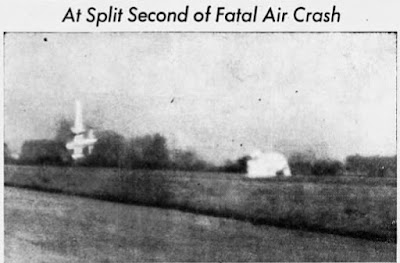On
November 5, 1945 the Wings of Victory Airmada buzzed over the city of Elmira.
The fleet of ten warplanes landed at the Chemung County Airport and prepared
for a three-day event celebrating the Victory Bond campaign. At the conclusion
of the event, two airplanes collided. Both were destroyed and six men lost
their lives.
 |
| Chemung County Airport, November 8, 1945 |
Maj.
Philip D. Wachtel Jr. of Truax Field, Madison, Wisconsin was Commander of the
fleet of fourteen military aircrafts. Because of the length of the air field in
Big Flats, only ten of the planes could land: B-17 Flying Fortress, B-25
Mitchell, A-26 Invader, P-51 Mustang, P-47 Thunderbolt, P-38 Lightning, C-46
Commando transport, C-47 Skytrain transport, AT-6 Texan trainer, and CG-10
cargo glider. The 34 members of the Airmada’s crew were assembled from eight
airfields throughout the country. Most of them had served overseas and been in
combat.
 |
| Wings of Victory Airmada crew, Star-Gazette, November 2, 1945 |
While
nearly 10,000 people got to explore the airplanes, the main purpose of the
Airmada was to raise money through Victory Bonds. Capt. Henry N. Hamington, pilot
of the B-17 Flying Fortress, and Capt. Bedford B. Riggan, pilot of the C-47
cargo ship, spoke to a large gathering of employees at Remington Rand. They
shared battle stories and urged people to buy bonds “to clinch the peace.” The
cargo glider was transformed into a Victory Bond booth on the airfield. The
Minute Maids, “the trim special event sales girls,” handed out bond order
blanks and signed people up for subscriptions. At the end of the second day of
the event, the glider was towed over to Schweizer Aircraft Corp where the
employees there held a bond rally around it.
 |
| Star-Gazette, November 9, 1945 |
At
around 10:30am, as the fleet was taking off to leave, the P-47 Thunderbolt
fighter and the B-25 Mitchell bomber collided in midair and burst into flames.
The five crewmen of the B-25 and the pilot of the P-47 were killed and debris
was strewn over more than 20 acres at the north end of the airport’s
north-south runway. Fortunately, the crash occurred far enough away from the
nearly 100 spectators who had gathered that none were injured.
Eyewitnesses
told the Star-Gazette that the P-47
appeared to be trying to come into formation with the B-25 when it crashed into
the bomber. An experienced combat pilot who was there did not think that the
pilot of the fighter actually saw the other plane. The blunt nose and
forward-set wings of the P-47 may have obstructed his view. Members of the Army
Air Forces Board of Inquiry from the Rome Air Base arrived that afternoon to
conduct an investigation but I never found a report in the press.
 |
| Photograph taken by Myron Mills, former Army Air
Corps pilot and amateur photographer, seconds after
the collision, Star-Gazette,
November 9, 1945
|
·
2nd
Lt. William J. Driver, Detroit, pilot
·
1st
Lt. Edwin S. Tyler, Saisun, California, pilot
·
1st
Lt. John L. Corum, Hopewell, Virginia, bombardier-navigator
·
Pfc.
Verrel C. Shook, Aurora, Indiana, engineer
·
Cpl.
Wilbur G. Heckner, Rochester, radio operator
·
1st
Lt. Merle R. Capp, Springfield, Missouri, P-47 pilot (veteran of 77 European
combat missions)


No comments:
Post a Comment